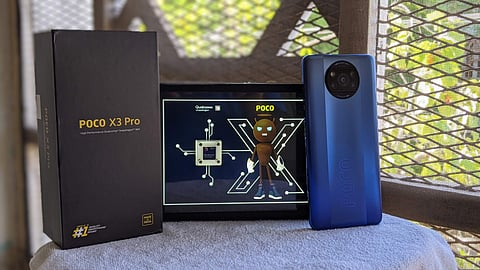
- LIFESTYLE
- FASHION
- FOOD
- ENTERTAINMENT
- EVENTS
- CULTURE
- VIDEOS
- WEB STORIES
- GALLERIES
- GADGETS
- CAR & BIKE
- SOCIETY
- TRAVEL
- NORTH EAST
- INDULGE CONNECT

The POCO F1 occupies an almost legendary status in Indian smartphone history, with the ‘uncompromised flagship performance at under twenty thousand’ equation turning out to be a huge success with Indian buyers. So much so, you’d see a “when is the successor to the POCO F1 coming?” response to each tweet or forum post from POCO or its representatives, but the interminable gap since the F1’s launch in 2018 made many wonder if a successor would ever launch. Until now, that is. Billed as the spiritual successor to the F1, the Poco X3 Pro inherits the same performance-first approach, but does it make the right compromises to hit that compelling price point?
If you’ve seen last year’s Poco X3, you’d be hard pressed to tell the difference in design, especially around the rear panel – the same matte polycarbonate back with the oversized camera module and dual-tone gradient finish with a subtle yet large POCO logo in the glossy strip that runs down the middle (hello, smudges!). While the weight distribution is balanced across the device, the device is among the heftiest out there at 213g and 9.4mm thick...and quite the handful. Flip side, there’s Gorilla Glass 6 protection on the display and IP53 rating for splashes if you’re less than careful. A high-res certified 3.5mm audio out port, an earpiece grill that serves as a second speaker, an infrared blaster, a notification LED and a side-mounted fingerprint sensor round out the functional design choices.
Around the front, you get a fairly large 6.67-inch full-HD+ LCD screen that offers a 120Hz refresh rate, 450 nits of brightness and a 240Hz touch sampling rate, the latter for improved touch responsiveness. There’s Widevine L1 certification for streaming HD content on streaming services like Netflix and Amazon Prime, but skips on HDR playback on both these services – you can watch HDR content on YouTube though, and the dual front-firing speakers are loud enough for casual gaming and calls. In terms of colors and vibrancy, POCO has used a good LCD panel, but it’s likely to be a tad underwhelming compared to the punchier AMOLED panels that the competition (from Xiaomi and Realme) have on offer.
Where the X3 Pro has pulled out the stops is in the choice of chipset under the hood. This is the first showing for the Qualcomm Snapdragon 860 chipset, a tweaked version of the flagship Snapdragon 855+ chipset that powered most 2019 flagships. An 800-series chip, even one that is a 2021-refresh of the bleeding edge from two years ago, under 20,000 is enough to pique my interest, and coupled with the 8GB of LPDDR4X memory, 128GB of snappy UFS 3.1 storage, does the X3 Pro deliver! Apps launch quickly, multi-tasking is breezy and the 120Hz refresh rate makes the overall experience buttery smooth. Casual everyday use aside, the X3 Pro flies through games like Asphalt 9 and Call of Duty Mobile with the highest graphics and frame rate options enabled, with only the slightest amount of noticeable heating to show for it. If there was one element that reminded me that this was made from the same mould as the POCO F1, this was it. The phone was able to eke out a day’s worth (about six hours of 120Hz screen time) from the 5160mAh battery, and the 33W fast charge adapter charged the phone in a little over an hour and a half. The only caveat with using the chip from 2019 is the lack of an integrated 5G modem, which may not be as big a deal in practical terms, but you’re going to have to cut through the 5G hype that the competition is pushing hard in the sub-20,000 segment. Software wise, the X3 Pro runs the POCO launcher atop MIUI 12.0.5 based on Android 11, which brings with it a slew of customization features and nifty add-ons. Bloatware does exist, some of which can be uninstalled, but the GetApps store is singularly responsible for a fair bit of notification spam.
On the camera front, POCO has used a 48MP primary, 8MP ultra-wide, and 2MP macro and depth sensors to make up the quad-camera setup on the X3 Pro. Shooting experience is similar to most recent Xiaomi phones – feature rich, though not the most intuitive. Daylight shots are reasonably detailed, with good dynamic range though somewhat muted colors. Image quality takes a dip when you switch away from the primary sensor, with details taking a hit and color science variations showing up across the various sensors. Night mode pictures are passable with some amount of artificial lighting, but the details and exposure levels aren’t segment-leading by any measure.
With the X3 Pro, it feels as if POCO set out to deliver the best possible performance at a compelling sub-20,000 price point, and in that regard, it has succeeded and how. Gamers looking for a great budget option that doesn’t break the bank would do well to consider the X3 Pro, and others could look at it from the perspective of future proofing, and the subtle looks, IP rating and stereo speakers are a good bonus. That said, since the phone does prioritize performance above all else, the display, heft and the cameras do take a bit of a back seat, so you’ll want to keep that in mind when rounding up the choices.
Highlights: Poco X3 Pro
Pros: Excellent performance for the segment, IP rating, good battery life, slick display, stereo speakers
Cons: Average cameras, bulky design, no 5G support
Rating: 8/10
Price: Rs. 18,999 for 6GB/128GB, Rs. 20,999 for 8GB/128GB